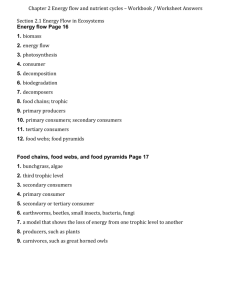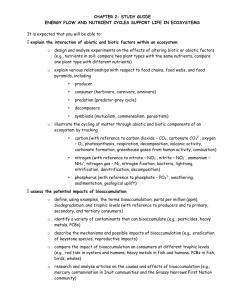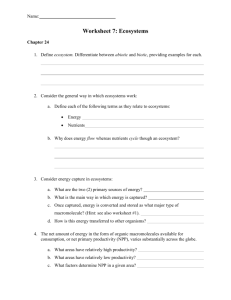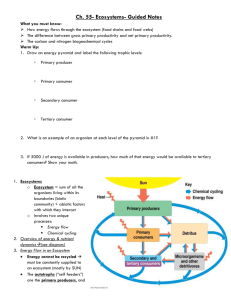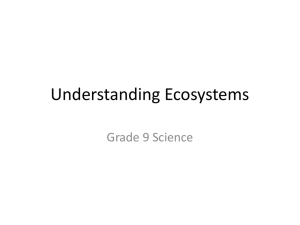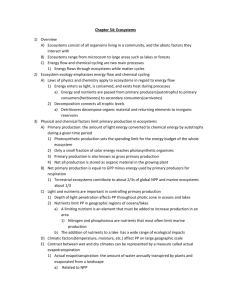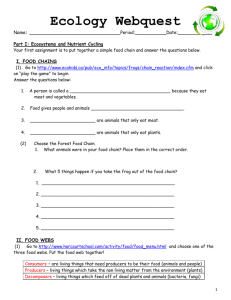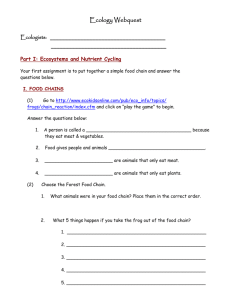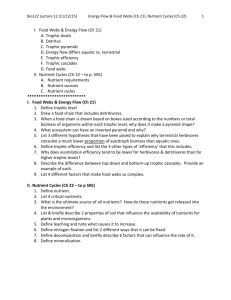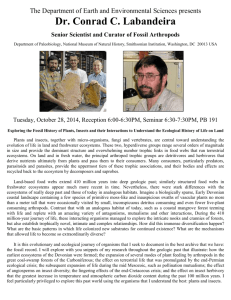Chapter 2 Energy flow and nutrient cycles – Workbook Answers
advertisement
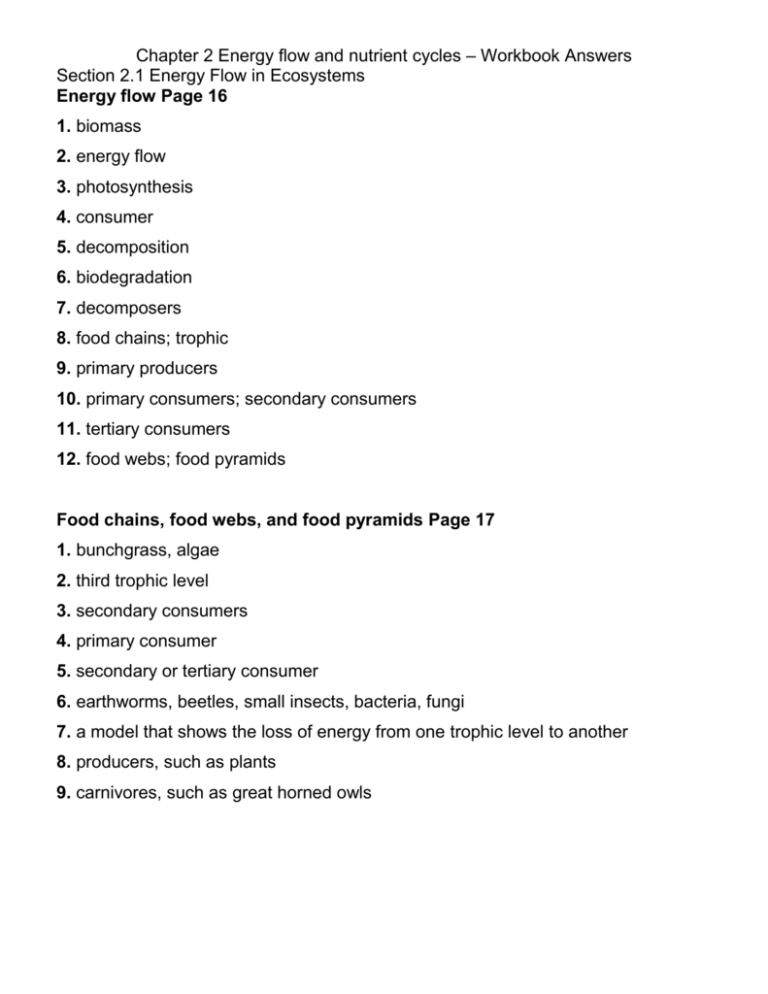
Chapter 2 Energy flow and nutrient cycles – Workbook Answers Section 2.1 Energy Flow in Ecosystems Energy flow Page 16 1. biomass 2. energy flow 3. photosynthesis 4. consumer 5. decomposition 6. biodegradation 7. decomposers 8. food chains; trophic 9. primary producers 10. primary consumers; secondary consumers 11. tertiary consumers 12. food webs; food pyramids Food chains, food webs, and food pyramids Page 17 1. bunchgrass, algae 2. third trophic level 3. secondary consumers 4. primary consumer 5. secondary or tertiary consumer 6. earthworms, beetles, small insects, bacteria, fungi 7. a model that shows the loss of energy from one trophic level to another 8. producers, such as plants 9. carnivores, such as great horned owls Modelling a local ecosystem Page 19 1. Student should include 12 organisms and cover all four trophic levels. 2. Food chain: student should include four trophic levels: primary producers, primary consumers, secondary consumers, and tertiary consumers. 3. Food web: student should include interconnecting arrows between various organisms to demonstrate the feeding relationships. 4. Food pyramid: student should show a series of boxes decreasing in size from bottom to top. The pyramid should include producers, herbivores, carnivores, and top carnivores. Energy flow in ecosystems Page 20 1. C 2. F 3. H 4. A 5. E 6. G 7. B 8. D 9. D 10. A 11. B 12. C 13. D 14. D Section 2.2 Nutrient Cycles in Ecosystems Nutrient cycles Page 24 1. Nutrients are stored in Earth’s atmosphere, oceans, and land masses. 2. Biotic processes, such as decomposition, and abiotic processes, such as river run-off, can cause nutrients to flow in and out of stores. 3. Photosynthesis converts solar energy into chemical energy. Carbon, in the form of carbon dioxide, enters through the leaves of plants and, in the presence of sunlight, reacts with water to produce carbohydrates and oxygen. 4. Cellular respiration involves carbohydrates reacting with oxygen to form carbon dioxide, water, and energy. 5. Decomposers, such as bacteria and fungi, convert organic molecules, such as cellulose, back into carbon dioxide, which is then released into the atmosphere. 6. Nitrogen fixation is the process in which nitrogen gas is converted into compounds that contain nitrate or ammonium. 7. Denitrification is a process by which denitrifying bacteria, using a series of chemical reactions, convert nitrate back into nitrogen gas. 8. Eutrophication is the process by which excess nutrients result in increased plant production and decay in aquatic ecosystems. The cycling of nutrients in the biosphere Page 25 1. Human activities that can affect a nutrient cycle could include land clearing, agriculture, urban expansion, mining, industry, and motorized transportation. 2. These human activities increase the amounts of nutrients in a cycle faster than natural biotic and abiotic processes can move them back into stores. 3. Terms and arrows could be similar to Fig 2.17 on page 70. Students may also add other facts or effects that they have thought of. 4. Changes in the carbon, nitrogen, and phosphorus cycles can affect the health and variety of organisms that live in an ecosystem. 5. Answers will vary but they should include a human activity, a description of the activity, and its impact on a specific part of the local ecosystem. The carbon, nitrogen, and phosphorus cycles Page 26 Nutrient cycles in ecosystems Page 29 1. F 2. A 3. E 4. B 5. D 6. G 7. C 8. B 9. A 10. D 11. C 12. B Section 2.3 Effects of Bioaccumulation on Ecosystems Bioaccumulation Page 33 1. bioaccumulation 2. keystone species 3. biomagnification 4. producers 5. PCBs 6. half-life 7. persistent organic pollutants 8. parts per million 9. heavy metals 10. lead; cadmium; mercury 11. bioremediation Impact of bioaccumulation on consumers Page 34 PCBs and the orca Page 36 1. PCBs are synthetic chemicals. Their full chemical name is polychlorinated biphenyl. 2. PCBs were used for industrial products, such as heat exchange fluids, paints, plastics, and lubricants for electrical transformers. 3. PCBs stay in the environment for a long time. Aquatic ecosystems and species that feed on aquatic organisms are especially sensitive to the effects of PCBs. PCBs bioaccumulate and biomagnify and also have a long half-life. 4. PCBs become concentrated in the orca’s blubber. 5. When salmon stocks are low, the orca’s blubber is burned for energy. The PCBs are released into the orca’s bloodstream and interfere with its immune system making it more susceptible to disease. 6. Diagram should be similar to Fig. 2.55 on page 95 of the student textbook. The pyramid should include the food chain for orcas and demonstrate the total PCB load that the orca is exposed to. Effects of bioaccumulation on ecosystems Page 37 1. F 2. D 3. E 4. B 5. C 6. A 7. C 8. D 9. B 10. C 11. A 12. D
